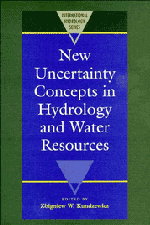Book contents
- Frontmatter
- Contents
- List of Authors
- Preface
- I INTRODUCTION
- II FACETS OF UNCERTAINTY
- III NOVEL APPROACHES TO UNCERTAINTY: FRACTALS, FUZZY SETS AND PATTERN RECOGNITION, NON-PARAMETRIC METHODS
- IV RANDOM FIELDS
- V TIME SERIES AND STOCHASTIC PROCESSES
- 1 Prediction uncertainty in seasonal partial duration series
- 2 A daily streamflow model based on a jump-diffusion process
- 3 The influence of time discretization on inferred stochastic properties of point rainfall
- 4 The distribution of the l-day total precipitation amount
- 5 Analysis of outliers in Norwegian flood data
- 6 Stochastic modelling of the operation of hydrants in an irrigation network
- 7 Order and disorder in hydroclimatological processes
- 8 Towards the physical structure of river flow stochastic process
- VI RISK, RELIABILITY AND RELATED CRITERIA
8 - Towards the physical structure of river flow stochastic process
Published online by Cambridge University Press: 07 May 2010
- Frontmatter
- Contents
- List of Authors
- Preface
- I INTRODUCTION
- II FACETS OF UNCERTAINTY
- III NOVEL APPROACHES TO UNCERTAINTY: FRACTALS, FUZZY SETS AND PATTERN RECOGNITION, NON-PARAMETRIC METHODS
- IV RANDOM FIELDS
- V TIME SERIES AND STOCHASTIC PROCESSES
- 1 Prediction uncertainty in seasonal partial duration series
- 2 A daily streamflow model based on a jump-diffusion process
- 3 The influence of time discretization on inferred stochastic properties of point rainfall
- 4 The distribution of the l-day total precipitation amount
- 5 Analysis of outliers in Norwegian flood data
- 6 Stochastic modelling of the operation of hydrants in an irrigation network
- 7 Order and disorder in hydroclimatological processes
- 8 Towards the physical structure of river flow stochastic process
- VI RISK, RELIABILITY AND RELATED CRITERIA
Summary
ABSTRACT The transformation of white noise and Markov processes through the simplified St. Venant flood routing model is examined. This model has been derived from the linearized St. Venant equation for the case of a wide uniform open channel flow with arbitrary cross-section shape and friction law. The only simplification results in filtering out the downstream boundary condition. The cross-correlation and normalized autocorrelation functions are determined in analytical way.
INTRODUCTION
The development of water resources research has created the need for an extension of mathematical analysis of hydrological data. An awareness of the stochastic structure of hydrologic processes is necessary for modelling water resources systems. The aim of the paper is to investigate the physical structure of the process of outflow from a river reach.
The widely accepted assumption about a structure of an inflow process is that it can be considered as a sum of deterministic and random components. It is assumed that the input signal is weekly stationary (stationarity of the first two moments).
It is assumed that the system behaves linearly. This is the crude simplification granting the compromise between simplicity and accuracy. The structure of the random component transformed by some conceptual linear flood routing models (linear reservoir, Nash, Muskingum) was examined by Strupczewski et al. (1975a, b). Some of their results are easily available (e.g. Singh, 1988, p. 240). In the present paper the structure of the random component transformed by the flood routing model based on the St. Venant equations will be analyzed.
- Type
- Chapter
- Information
- New Uncertainty Concepts in Hydrology and Water Resources , pp. 261 - 270Publisher: Cambridge University PressPrint publication year: 1995
- 1
- Cited by

